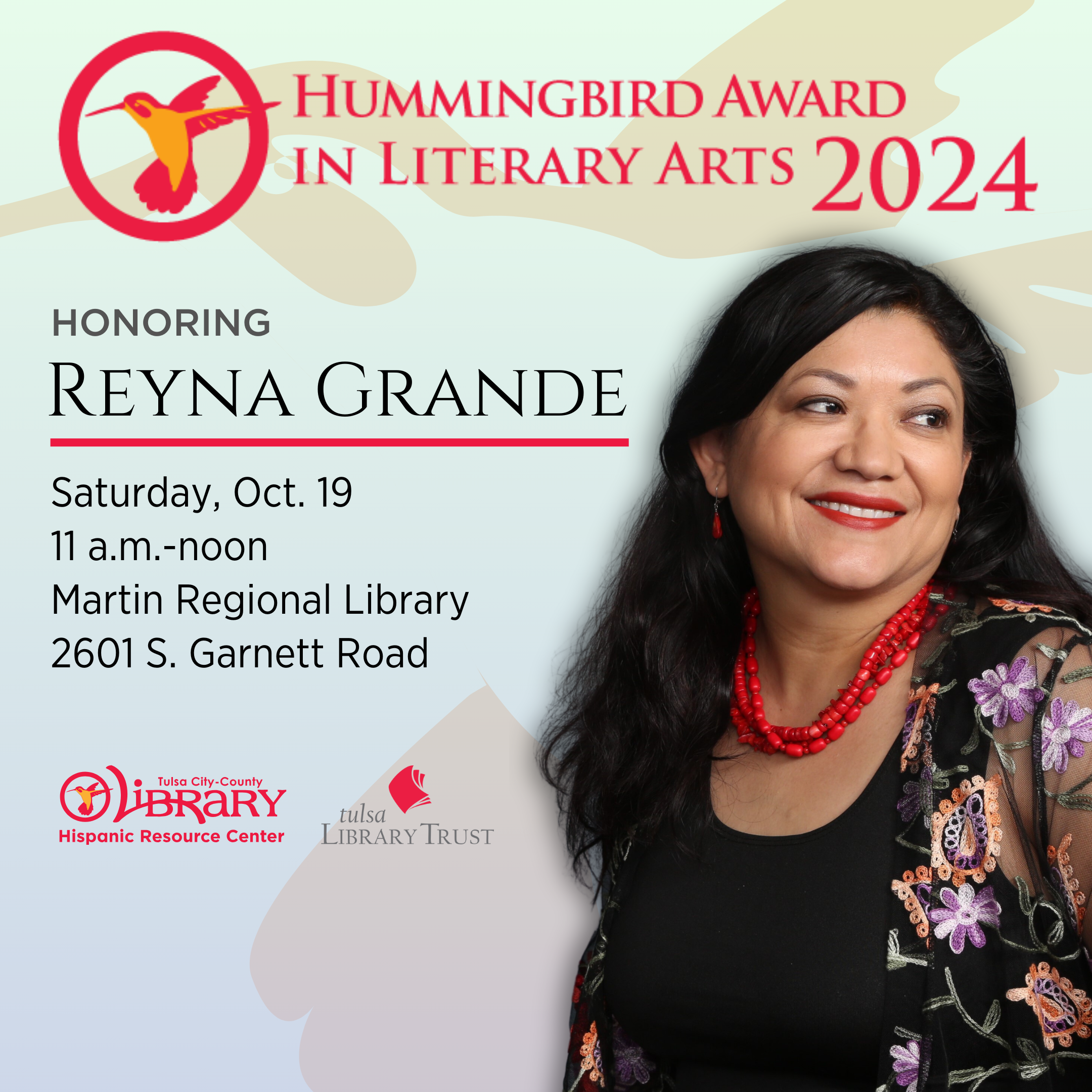The Hispanic Resource Center is thrilled to announce that Reyna Grande, the acclaimed American Book Award-winning novelist and memoirist, has been chosen to receive the 2024 Hummingbird Award in Literary Arts.

About Reyna Grande:
Reyna Grande is the author of the bestselling memoirs The Distance Between Us and A Dream Called Home, where she shares her experiences before and after arriving in the United States from Mexico as an undocumented child immigrant. Her other notable works include the novels Across a Hundred Mountains, Dancing With Butterflies, and A Ballad of Love and Glory, which is set during the Mexican-American War. Additionally, she co-edited the anthology Somewhere We Are Human: Authentic Voices on Migration, Survival and New Beginnings, featuring stories by and about undocumented Americans.
Born in Iguala, Guerrero, Mexico, Reyna Grande was just 2 years old when her father left for the U.S. to find work, followed by her mother two years later. In 1985, at the age of 9, Reyna made her own journey north. She attended Pasadena City College before transferring to the University of California, Santa Cruz, where she became the first in her family to graduate from university.
Hummingbird Award in Literary Arts
Past Recipients
2022
Benjamin Alire Sáenz
Award Criteria & Selection Process
Terms
- One plaque and monetary award will be presented every two years at a Tulsa City-County Library awards ceremony. The award will be presented to a Latinx author, poet, or artist whose outstanding work has adequately captured the experience and voice of the Latinx community.
- The selected author or artist may specialize in any age category, genre, and their work may be available in Spanish, English, or bilingual formats (work in a language native to a region and/or spoken by indigenous communities also qualifies).
- The author or artist must be of Latinx heritage or descent to be a recipient of the award.
- If suitable candidates are not found, the awards will not be presented in that year.
The Process: Selecting a Candidate
- The process of selecting a candidate will take 2-3 months with an estimate of 3 meetings total, of which only 1 is required to be in-person. This will give enough time for the committee to research or read the work of the candidates as they are being proposed and evaluated during the meetings.
- The first task of the selection committee will be to generate a longlist of candidates. This longlist will be created by asking each committee member to submit 2-3 names to the list by-email within a week of the process beginning.
- Staff advisory members will create author profiles for all nominees and give the committee 2 weeks to review them.
- The committee will then convene in-person to narrow down the longlist to a shortlist.
- The final process is giving the committee one month after the in-person meeting to research/read about the shortlist nominees and rank them from 1-5. Scorecards/Rankings will be due to the HRC Coordinator within a month.
- After the staff advisory members combine the totals of the rankings and come up with the ranked list of 3 finalists, we'll start reaching out to them in ranked order until one accepts.
Author Selection Committee Commitment & Roles
The HRC Author Selection Committee composed of members of the community will vote from a narrowed list of award candidates to decide on 2 ranked finalists, and an alternate finalist. The HRC Author Selection Committee will serve a term of 2 cycles, and since the award is biennial, the members are invited to serve on the committee for 4 years. This is not a strict time commitment, as we understand special circumstances may change availability. The committee will be made up of at least three leaders or community partners of the Latinx/Hispanic community in Tulsa and non-voting TCCL staff that will have the ability advise on the list of candidates for voting members.
Voting
Voting will be conducted through a point system; the voting members will be asked to assess and pick from a list of 5 candidates for the award. They will pick their 1st choice, 2nd choice and 3rd Choice. At the end, first choice picks will be worth 3 points, 2nd will be worth 2 points, and 3rd choice will be worth 1. Points will be totaled and we will ideally have 2 finalists, and an alternate finalist.
Symbolism
- For the Taino, the hummingbird is a symbol of rebirth, and even though they are small, they have the fierce heart of an eagle. The Taino People call their warriors the “Colibri” Warriors, which translates to Hummingbird Warriors. The Taíno were an Arawak people who were the indigenous people of the Caribbean and Florida. At the time of European contact in the late 15th century, they were the principal inhabitants of most of Cuba, Jamaica, Hispaniola (the Dominican Republic and Haiti), and Puerto Rico.
- Huitzilopochtli, also spelled Uitzilopochtli, also called Xiuhpilli (“Turquoise Prince”) and Totec (“Our Lord”), Aztec sun and war god, one of the two principal deities of Aztec religion, often represented in art as either a hummingbird or an eagle.
- Huitzilopochtli’s name is a cognate of the Nahuatl words huitzilin, “hummingbird,” and opochtli, “left.” Aztecs believed that dead warriors were reincarnated as hummingbirds and considered the south to be the left side of the world; thus, his name meant the “resuscitated warrior of the south.” His other names included Xiuhpilli (“Turquoise Prince”) and Totec (“Our Lord”). His nagual, or animal disguise, was the eagle.
- Huitzilopochtli’s mother, Coatlicue, is one aspect of the Aztecs’ multidimensional earth goddess; she conceived him after having kept in her bosom a ball of hummingbird feathers (i.e., the soul of a warrior) that fell from the sky. According to tradition, Huitzilopochtli was born on Coatepec Mountain, near the city of Tula.
